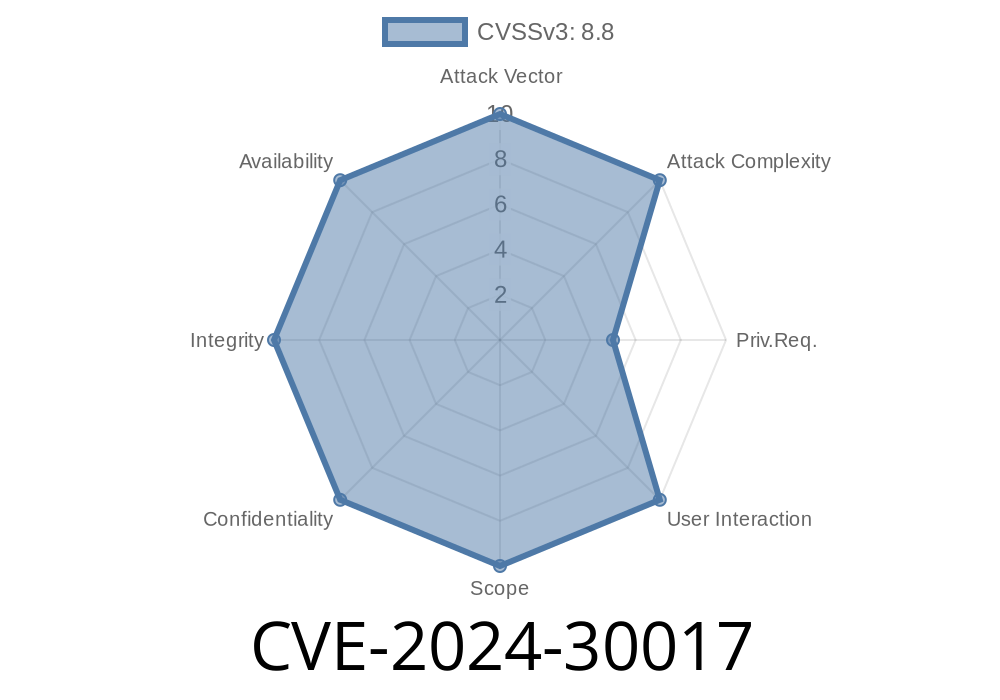---
Introduction
In May 2024, Microsoft released patches for a serious vulnerability, CVE-2024-30017, affecting Windows Hyper-V. This vulnerability allows attackers to execute remote code on the host machine through malformed inputs from a guest VM. If exploited, an attacker could potentially take over the underlying host server, putting your entire virtualization infrastructure at risk.
This post breaks down what CVE-2024-30017 is, how it works, and shows you code snippets explaining the vulnerability. I'll also point to official references and resources for patching and more details. Think of this as your plain-English guide so you can be aware and defend your systems.
What is Windows Hyper-V?
Hyper-V is Microsoft’s built-in solution for running multiple virtual machines (VMs) on Windows Servers and desktops. It is widely used in enterprise networks, test environments, and anywhere virtualized Windows is needed.
What is CVE-2024-30017?
CVE-2024-30017 is a vulnerability in Hyper-V, specifically in the way it handles synthetic device messages from guest VMs to the host. A malicious or compromised VM could send crafted data to the Hyper-V host, causing memory corruption that leads to _remote code execution (RCE)_.
Severity: Critical (CVSS 8.8)
- Affected OS: Windows Server 2016/2019/2022, Windows 10/11 with Hyper-V enabled
Impact: Complete takeover of the host; further lateral movement possible
> Microsoft’s advisory on CVE-2024-30017
How Does the Exploit Work?
The vulnerability lies in how Hyper-V parses and handles VM bus (VMBus) synthetic device packets. Hyper-V does not correctly validate some fields in these packets, allowing an attacker to perform a heap buffer overflow or use-after-free vulnerability.
1. Malformed Device Packet Sent by Guest
The attacker on a guest VM crafts a VMBus message that takes advantage of validation flaw.
# Pseudocode example from a research PoC
# Guest VM code sends malformed VMBus packets
vmbus_packet = {
"Type": "Synthetic_NIC",
"DataLength": xFFFFFFF, # Large invalid length
"Payload": b"A" * 64 # Arbitrary data
}
send_to_vmbus_host(vmbus_packet)
2. Host Heap Corruption
On the Hyper-V host, memory parsing fails because the DataLength isn't properly checked, leading to heap overflow.
// Simplified Host (Hyper-V) Side Function
void ProcessVMDevicePacket(VMBusPacket *pkt) {
char buffer[256];
// Vulnerable: Doesn't validate DataLength field
memcpy(buffer, pkt->Payload, pkt->DataLength);
// ... further processing
}
If pkt->DataLength is huge, memcpy will overflow buffer, corrupting heap memory and potentially letting attacker run arbitrary code.
3. Remote Code Execution
If the attacker carefully crafts the payload, this heap corruption lets them control the flow of execution — such as overwriting function pointers or execution addresses.
Can This Be Exploited Remotely?
Yes — the attack happens _from a guest VM_, which is "remote" from the Hyper-V host’s perspective. So if you are running VMs from untrusted sources (multi-tenant, cloud, or compromised guests), you are at real risk.
Exploit Details (Hypothetical PoC)
While there is, as of June 2024, no public proof-of-concept (PoC) exploit code, security researchers have confirmed exploitation is straightforward with knowledge of Hyper-V’s internals.
Here’s a conceptual PoC in Python (does NOT exploit for RCE, just shows sending the malformed packet):
import os
def send_to_vmbus_host(packet):
# For illustration—actual attack would use VMBus low-level access
print(f"Sending packet: {packet}")
packet = {
"Type": "Synthetic_NIC",
"DataLength": xDEADBEEF, # Too large
"Payload": b"EXPLOIT" * 40
}
send_to_vmbus_host(packet)
Note: Actual exploit on Hyper-V would require specialized guest-to-host channel access, which cannot be reproduced in regular scripts, but serves to illustrate the problem flow.
How to Defend Against CVE-2024-30017
1. Patch Immediately:
Check and apply the June 2024 Microsoft updates. This closes the underlying memory handling bug.
- Microsoft Security Update Guide
2. Restrict Guest Access:
Don’t let untrusted users or code run on your VMs. Limit tenant or customer code if you’re running multi-tenant infrastructure.
3. Monitor for Abnormal Activity:
Look for unexpected system crashes, service restarts, or heap corruption logs on your Hyper-V hosts.
4. Use Hyper-V Shielded VMs
Hyper-V has extra security modes (like Shielded VMs) which can provide defense in depth.
References
- Microsoft CVE-2024-30017 Advisory
- Microsoft Hyper-V Security Best Practices
- MSRC June 2024 Security Updates
Final Thoughts
If you use Hyper-V, patch now. CVE-2024-30017 has the potential for devastating host takeovers — an attacker with control over even a single guest VM could gain admin rights over your entire host. Always keep your virtualization stack up to date and practice solid security hygiene.
If you want to know more or need help patching, reach out in the Microsoft Hyper-V forums.
Timeline
Published on: 05/14/2024 17:16:48 UTC
Last modified on: 06/19/2024 20:58:30 UTC
